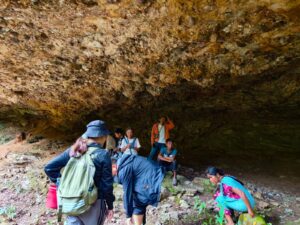Umsawwar is a village tucked away in East Khasi Hills district of Meghalaya. It is one of the participating villages of NESFAS and is part of the ongoing project, “Protection of forests in Meghalaya by adopting participatory, gender centric and equitable approaches‘ ‘, funded by The Nature Conservancy. The village has gained wide popularity recently as a hotspot for tourists. Many visitors from all over the world flock there to catch a glimpse of the majestic waterfall, known as Synrang Khyiet. At a height of approximately 100 ft, this cascading natural beauty is especially alluring during the monsoons.
The significance of the name Synrang Khyiet is in the fact that it is named after one of the famous animals found in this place, the Muntjac deer. Synrang Khyiet literally translates to cave of the muntjac deer. Also known as barking deer, or rib-faced deer, the muntjac deer are small deer of the genus Muntiacus native to South Asia and Southeast Asia. Their habitat includes areas of dense vegetation, rainforests, monsoon forests and they like to be close to a water source. The animal is known to come to the cave beneath the waterfall during the winter and the monsoon seasons for food and shelter. During monsoons, the weather is warm and the deer visits the cave to drink water that falls on the big rocks or the caves. As for winters, it gives them shelter at night and the area also has an abundance of food. However, owing to overpopulation and deforestation in their natural habitat, the muntjac deer has now become extinct. Once found aplenty in places like Dawki, the muntjac deer can now no longer be found wandering about the waterfall or its surrounding areas. The community members realized that the deer had gone extinct, after no sightings were reported from the people who had gone into the forests. The deer now only lives in the folktales told orally from the older to the younger generations, and the latter has failed to recognize the species that were once found aplenty in their region. Hence, the members of the community have circulated a warning stating that, should anyone spot a rare wild animal or two in and around the forests, they should not engage in the act of killing or hunting the species and must preserve them for the years to come. Whether it is an action taken too late, or just in the nick of time, remains to be seen.






